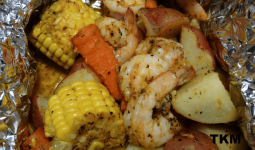Welcome to the world of white rice, a staple food in many cultures around the world. White rice is simply rice that has had its husk, bran, and germ removed.
This process gives the grains a polished, white appearance, hence the name.
White rice is cherished for its versatility and ability to complement a variety of dishes.
Nutritional Composition of White Rice
Taking a look at the nutritional aspects of white rice, it’s primarily made up of carbohydrates, with small amounts of protein and virtually no fat.
White rice also contains a small amount of minerals such as iron and calcium.
The table below gives you an idea of the nutrient composition of a cup of cooked white rice.
| Nutrient | Amount |
|---|---|
| Calories | 205 |
| Protein | 4.3g |
| Fat | 0.4g |
| Carbohydrates | 44.5g |
| Fiber | 0.6g |
| Calcium | 15.8mg |
| Iron | 1.9mg |
It’s important to note that while white rice may seem low in fiber and certain vitamins, it’s often enriched with vitamins and minerals during processing.
As you continue your journey to discover how many calories in white rice, keep in mind that the nutritional value of any food is not just about calories but also about the nutrients it provides.
If you’re interested in learning more about calories and how they contribute to your diet, you might find our article on what is calorie counting useful.
The Caloric Content of White Rice
In the world of calorie counting, understanding the caloric content of everyday foods like white rice is key to managing your diet effectively.
Understanding Calories
A calorie is a unit of energy that your body uses to perform daily essential functions and physical activities.
Everything you eat and drink, with the exception of water, contains calories. However, not all calories are created equal.
They can come from various sources, like carbohydrates, proteins, and fats, each having different effects on your health.
If you want to learn more about it, check out our article on what is calorie counting.
How Many Calories in White Rice?
So, you might be wondering, “How many calories are in white rice?” A cup of cooked white rice, which typically weighs around 186 grams, contains approximately 205 calories.
It’s important to remember that these are approximate values, and the actual caloric content can vary based on the type of rice and the cooking process.
| Type of White Rice | Calories per Cup (Cooked) |
|---|---|
| Long Grain | 205 |
| Medium Grain | 242 |
| Short Grain | 266 |
Remember, while white rice is a significant source of calories, it’s also an essential part of many diets worldwide due to its high carbohydrate content and various nutrients.
When consumed in moderation and as part of a balanced diet, white rice can be a part of your healthy eating plan.
If you’re curious about the caloric content of other foods in your diet, you might want to check out our articles on how many calories in fried rice or how many calories in half a cup of rice for comparison.
Comparing Caloric Content
When it comes to calorie counting, it’s important to consider how foods stack up against each other.
In this section, we’ll compare the calories in white rice to those in brown rice and other common foods.
This can provide a clearer picture of how white rice fits within your overall diet.
White Rice vs Brown Rice
If you’re a fan of rice, you’ve probably wondered about the caloric difference between white and brown rice.
Here’s a quick comparison:
| Rice Type | Calories per cup (cooked) |
|---|---|
| White Rice | 205 |
| Brown Rice | 216 |
As you can see, brown rice has slightly more calories than white rice.
However, brown rice is often recommended for its high fiber content and other nutritional benefits.
Learn more about the calories in brown rice here.
White Rice vs Other Common Foods
Now, let’s see how white rice stacks up against other common foods.
| Food | Calories per serving |
|---|---|
| White Rice (1 cup, cooked) | 205 |
| Scrambled Eggs (2 eggs) | 200 |
| Slice of Pizza | 285 |
| French Fries (medium serving) | 365 |
| Grilled Chicken (100g) | 165 |
From the table, you can see that white rice has fewer calories than a slice of pizza or a medium serving of French fries but more than scrambled eggs or grilled chicken.
This comparison can help you make informed choices based on your daily calorie allowance.
Remember, the key to a balanced diet is not just counting calories but also considering the nutritional value of your foods.
For more information on calorie counting, check out our article on what is calorie counting.
Understanding the Impact of Cooking Methods
The way you cook your white rice can have a significant impact on its caloric content.
This section will explore three common cooking methods: boiling, steaming, and frying.
Boiled White Rice
Boiling is one of the most common ways to cook white rice.
This method involves immersing the rice in water, bringing it to a boil, and then reducing the heat to let it simmer until all the water is absorbed.
Boiled white rice has fewer calories than other cooking methods, as it does not involve any oils or fats.
A cup of boiled white rice contains approximately 205 calories.
Steamed White Rice
Steaming is another healthy way to cook white rice. In this method, the rice is cooked using steam, which helps retain the nutrients while keeping the caloric content low.
A cup of steamed white rice contains roughly 200 calories.
Remember that these values can vary slightly based on the type of rice and the exact cooking process.
Fried White Rice
Fried white rice is a popular dish in many cuisines but is also the highest in calories among the three cooking methods.
This is because frying involves the use of oil, which significantly increases the calorie content.
A cup of fried white rice can contain anywhere from 250 to 370 calories, depending on the amount of oil used.
| Cooking Method | Calories per Cup |
|---|---|
| Boiled | 205 |
| Steamed | 200 |
| Fried | 250 – 370 |
By understanding how different cooking methods affect the calorie content of white rice, you can make more informed decisions about your diet.
Remember, balance is key. You can enjoy your favorite dishes while still keeping an eye on your calorie intake.
For more information about calories and how they impact your health, check out our article on what is calorie counting.
Tips for Including White Rice in a Balanced Diet
While understanding how many calories in white rice is crucial, especially if you are monitoring your caloric intake, it’s equally important to know how to incorporate it into a balanced diet.
Here are some tips to help you enjoy white rice while keeping your calorie count in check.
Portion Control
The first step towards including white rice in a balanced diet is practicing portion control.
A typical serving of cooked white rice is about a half cup, which contains around 100-120 calories.
If you are wondering how many calories in half a cup of rice, you can check out our detailed post.
Remember, the key is moderation. Consuming large portions can quickly increase your calorie intake.
Pairing with Nutrient-Rich Foods
While white rice is low in fat and a source of quick energy, it’s not particularly rich in other nutrients.
To make your meal healthier, consider pairing white rice with nutrient-rich foods.
This could include lean proteins, such as chicken or fish, and a variety of vegetables.
Not only will this provide a balance of nutrients, but it can also keep you feeling full and satisfied.
You can refer to our articles to understand how pairing with these foods can affect your total caloric intake:
- how many calories in grilled chicken
- how many calories in two scrambled eggs
- how many calories in a slice of cheese
Modifying Cooking Methods
The way you cook white rice can greatly influence its caloric content. For instance, fried rice will have significantly more calories due to the added fats and oils.
If you’re curious about how many calories in fried rice, our article provides in-depth information.
Instead, consider methods such as boiling or steaming, which do not require additional fats.
This can be a simple but effective way to keep your meals’ calorie count in check without giving up your favorite grain.
Remember, while white rice can be part of a balanced diet, paying attention to serving sizes, the foods you pair it with, and the cooking methods you use is important.
This way, you can enjoy your meals while staying on track with your health and wellness goals.








